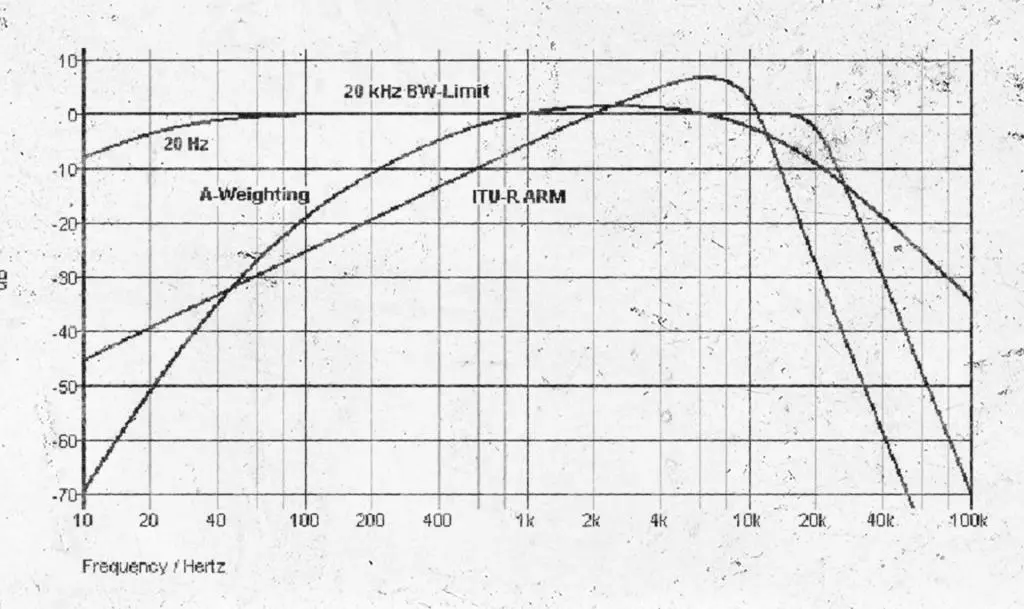Simply put A-Weighting refers to introduction of a filter to reduce certain frequencies when measuring sound in order to obtain results that match better with the frequency response of our ears / audition. One thing is important to mention here. Though A-Weighting has many important uses or applications, some audio gear, even pro audio gear manufacturers use A-weighting when making measurements for the specifications for their gear in order to disguise poor performance.

What is A-Weighting: Table of Contents
If you’ve ever been in a noisy environment or listened to music at a high volume, you might have noticed that different sounds can have varying degrees of loudness. While the human ear can detect a wide range of sound frequencies, it is not equally sensitive to all of them. This is where A-weighting comes in.
A-weighting is a method of adjusting sound measurements to account for the varying sensitivity of the human ear to different frequencies. It applies a frequency response weighting to sound measurements in order to provide a more accurate representation of the sound as perceived by humans.
How A-Weighting Works
To understand A-weighting, it’s helpful to have a basic understanding of how the human ear perceives sound. Sound waves are vibrations that travel through the air and are detected by the ear. These vibrations are measured in units of frequency, known as hertz (Hz). The human ear can detect sound waves with frequencies ranging from 20 Hz to 20,000 Hz, although sensitivity varies across this range.
The sensitivity of the human ear to different frequencies is not uniform. The ear is most sensitive to frequencies between 2,000 Hz and 5,000 Hz, and less sensitive to frequencies outside of this range. A-weighting takes this sensitivity into account by applying a filter to sound measurements that reduces the levels of certain frequencies that are not as audible to humans. This is done in order to better match the frequency response of the human ear and provide more accurate measurements of perceived loudness.
The A-weighting filter is a type of frequency weighting that is commonly used in sound measurement instruments. The filter is applied to sound measurements by multiplying the sound pressure level (SPL) at each frequency by a weighting factor. The weighting factor varies based on frequency and is determined by a set of standardized curves that represent the frequency response of the human ear. The resulting weighted SPL values are then summed to produce a single A-weighted sound level (dBA).
Applications of A-Weighting
A-weighting is used in many industries, including environmental noise monitoring, industrial hygiene, and workplace safety, to ensure that sound levels are measured and reported accurately. Here are some examples of how A-weighting is used in practice:
Environmental Noise Monitoring
A-weighting is commonly used in environmental noise monitoring to measure the noise levels in a particular area. This is important for assessing the impact of noise on nearby communities and wildlife. For example, environmental noise monitoring might be used to measure the noise levels from a construction site or a highway. A-weighting is used in this context to better reflect the noise levels as perceived by humans.
Industrial Hygiene
A-weighting is also used in industrial hygiene to measure the noise levels in workplaces, such as factories or construction sites. In these environments, workers may be exposed to high levels of noise that can damage their hearing. A-weighting is used to accurately measure the noise levels that workers are exposed to and to ensure that they are within safe limits.
Workplace Safety
A-weighting is an important tool for workplace safety, particularly in industries where workers are exposed to high levels of noise. Employers are required by law to provide a safe working environment, and A-weighting is one of the tools used to ensure that noise levels are within safe limits. By accurately measuring the noise levels that workers are exposed to, employers can take steps to reduce noise levels and prevent hearing damage.
Other Applications
A-weighting is also used in the music and entertainment industries to ensure that sound levels are safe and enjoyable for audiences. For example, A-weighting might be used to measure the sound levels at a concert venue to ensure that they are not damaging to the hearing of the audience.
Limitations of A-Weighting
While A-weighting is a useful tool for accurately measuring sound levels as perceived by humans, it does have some limitations. One limitation is that it only applies to steady-state sounds, which are sounds that have a constant level over time. A-weighting is not suitable for measuring impulsive sounds, which are sounds that have a sudden onset and decay rapidly.
Another limitation of A-weighting is that it does not take into account individual differences in hearing sensitivity. While the standardized A-weighting curves are based on the average sensitivity of a group of people, individual sensitivity can vary based on age, sex, and other factors.
Misuse of A-Weighting
Despite its many useful applications, A-weighting is sometimes misused by manufacturers of audio equipment. In some cases, manufacturers use A-weighting when making measurements for the specifications of their gear in order to disguise poor performance. This is because A-weighting can make gear appear to perform better than it actually does in certain situations.

